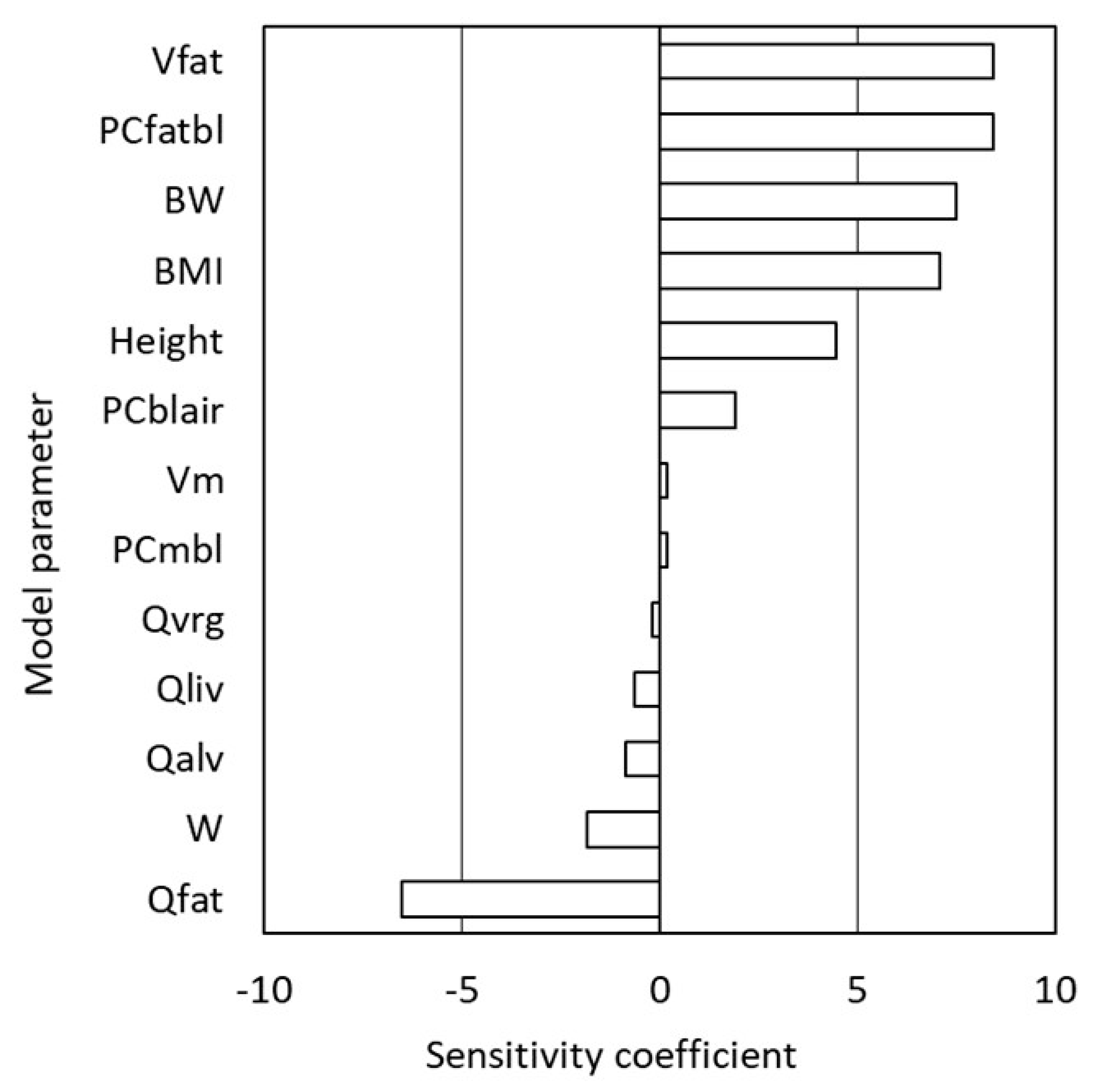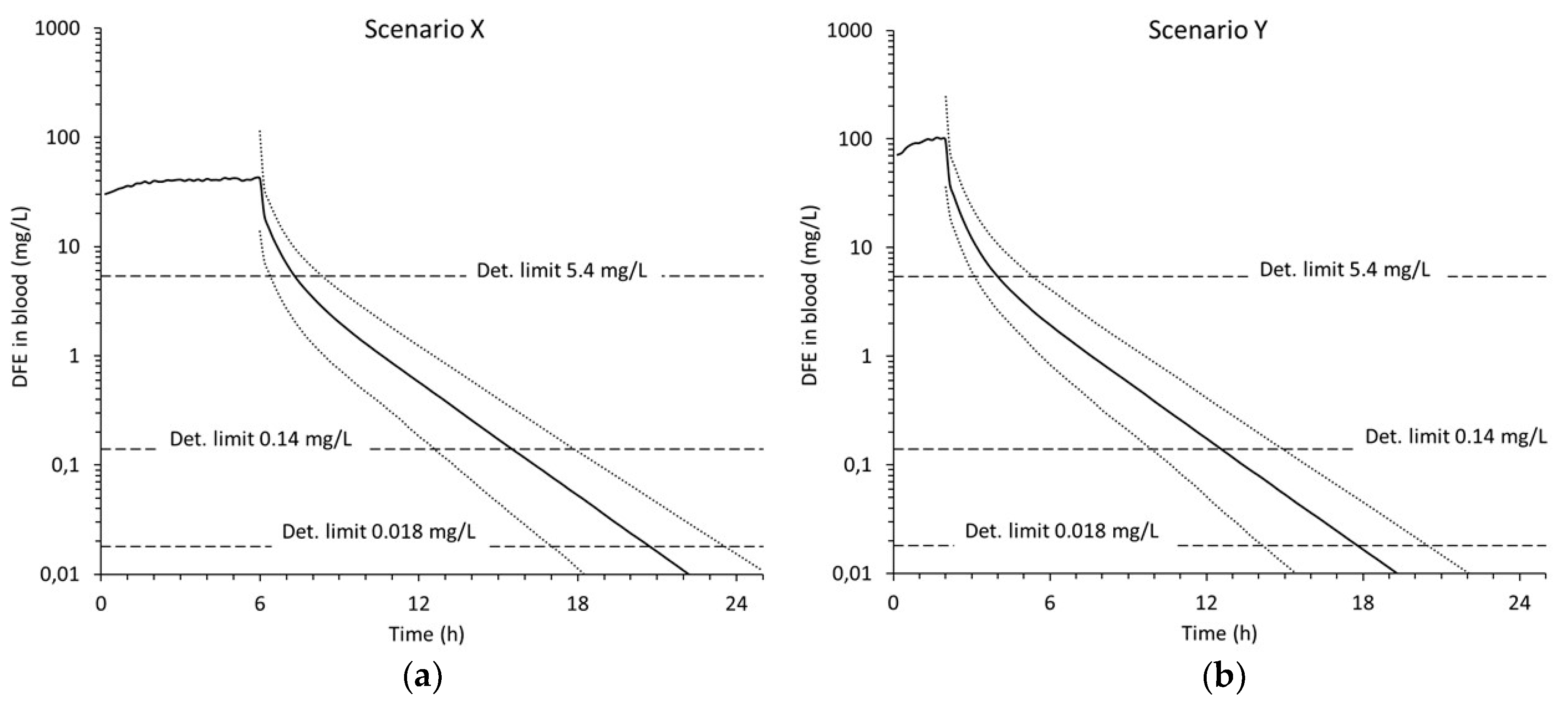1,1-Difluoroethane Detection Time in Blood after Inhalation Abuse Estimated by Monte Carlo PBPK Modeling
Abstract
:1. Introduction
2. Materials and Methods
2.1. PBPK Model
2.2. Exposure Scenarios
2.3. Detection Limit(s) for DFE in Blood
2.4. Influence of BMI
2.5. Monte Carlo Simulations
2.6. Ethical considerations
3. Results
4. Discussion
Author Contributions
Funding
Acknowledgments
Conflicts of Interest
References
- Miech, R.A.; Johnston, L.D.; O’Malley, P.M.; Bachman, J.G.; Schulenberg, J.E.; Patrick, M.E. Monitoring the Future. National Survey Results on Drug Use, 1975–2019. Volume I, Secondary School Students. Available online: http://www.monitoringthefuture.org//pubs/monographs/mtf-vol1_2019.pdf (accessed on 16 July 2020).
- SAMHSA. Key Substance Use and Mental Health Indicators in the United States: Results from the 2019 National Survey on Drug Use and Health: Detailed Tables. Available online: https://www.samhsa.gov/data/sites/default/files/reports/rpt29394/NSDUHDetailedTabs2019/NSDUHDetTabsSect1pe2019.htm (accessed on 11 September 2020).
- Wu, L.T.; Pilowsky, D.J.; Schlenger, W.E. Inhalant abuse and dependence among adolescents in the United States. J. Am. Acad. Child Adolesc. Psychiatry 2004, 43, 1206–1214. [Google Scholar] [CrossRef] [PubMed] [Green Version]
- Wu, L.T.; Howard, M.O. Psychiatric disorders in inhalant users: Results from The National Epidemiologic Survey on Alcohol and Related Conditions. Drug Alcohol Depend. 2007, 88, 146–155. [Google Scholar] [CrossRef] [PubMed] [Green Version]
- NIH. National Institute on Drug Abuse. Drug Facts. Inhalants. Available online: https://www.drugabuse.gov/sites/default/files/drugfacts-inhalants.pdf (accessed on 15 July 2020).
- Perry, H.; Burns, M.M.; Wiley, J.F. Inhalant Abuse in Children and Adolescents. Available online: https://www.uptodate.com/contents/inhalant-abuse-in-children-and-adolescents (accessed on 15 July 2020).
- MayoClinicStaff. Inhalant Use: Is Your Child at Risk? Available online: https://www.mayoclinic.org/healthy-lifestyle/tween-and-teen-health/in-depth/inhalant-abuse/art-20044510 (accessed on 15 July 2020).
- Williams, J.F.; Storck, M.; American Academy of Pediatrics Committee on Substance Abuse; American Academy of Pediatrics Committee on Native American Child Health. Inhalant abuse. Pediatrics 2007, 119, 1009–1017. [Google Scholar] [CrossRef] [PubMed] [Green Version]
- ECETOC. 1,1-Difluoroethane (HFC-152a). JACC Report. Available online: http://www.ecetoc.org/wp-content/uploads/2014/08/JACC-045.pdf (accessed on 16 July 2020).
- Ernstgard, L.; Sjogren, B.; Dekant, W.; Schmidt, T.; Johanson, G. Uptake and disposition of 1,1-difluoroethane (HFC-152a) in humans. Toxicol. Lett. 2012, 209, 21–29. [Google Scholar] [CrossRef]
- Keller, D.A.; Roe, D.C.; Lieder, P.H. Fluoroacetate-mediated toxicity of fluorinated ethanes. Fundam. Appl. Toxicol. 1996, 30, 213–219. [Google Scholar] [CrossRef]
- Ema, M.; Naya, M.; Yoshida, K.; Nagaosa, R. Reproductive and developmental toxicity of hydrofluorocarbons used as refrigerants. Reprod. Toxicol. 2010, 29, 125–131. [Google Scholar] [CrossRef]
- Avella, J.; Kunaparaju, N.; Kumar, S.; Lehrer, M.; Zito, S.W.; Barletta, M. Uptake and distribution of the abused inhalant 1,1-difluoroethane in the rat. J. Anal. Toxicol. 2010, 34, 381–388. [Google Scholar] [CrossRef] [Green Version]
- Broussard, L.A.; Brustowicz, T.; Pittman, T.; Atkins, K.D.; Presley, L. Two traffic fatalities related to the use of difluoroethane. J. Forensic Sci. 1997, 42, 1186–1187. [Google Scholar] [CrossRef]
- Avella, J.; Wilson, J.C.; Lehrer, M. Fatal cardiac arrhythmia after repeated exposure to 1,1-difluoroethane (DFE). Am. J. Forensic Med. Pathol. 2006, 27, 58–60. [Google Scholar] [CrossRef]
- Bass, M. Sudden sniffing death. JAMA 1970, 212, 2075–2079. [Google Scholar] [CrossRef]
- Groppi, A.; Polettini, A.; Lunetta, P.; Achille, G.; Montagna, M. A fatal case of trichlorofluoromethane (Freon 11) poisoning. Tissue distribution study by gas chromatography-mass spectrometry. J. Forensic Sci. 1994, 39, 871–876. [Google Scholar] [CrossRef] [PubMed]
- Xiong, Z.; Avella, J.; Wetli, C.V. Sudden death caused by 1,1-difluoroethane inhalation. J. Forensic Sci. 2004, 49, 627–629. [Google Scholar] [CrossRef] [PubMed]
- Dunn, W.A.; Jackson, G.F.; Breton, G.; Albano, E.H. An unusual finding of 1,1-difluoroethane in a drowning victim. ToxTalk 2009, 33, 9. [Google Scholar]
- Kuspis, D.A.; Krenzelok, E.P. Oral frostbite injury from intentional abuse of a fluorinated hydrocarbon. J. Toxicol. Clin. Toxicol. 1999, 37, 873–875. [Google Scholar] [CrossRef] [PubMed]
- Winston, A.; Kanzy, A.; Bachuwa, G. Air Duster abuse causing rapid airway compromise. BMJ Case Rep. 2015, 2015. [Google Scholar] [CrossRef]
- Calhoun, K.; Wattenbarger, L.; Burns, E.; Hatcher, C.; Patel, A.; Badam, M.; Khan, A.J. Inhaling Difluoroethane Computer Cleaner Resulting in Acute Kidney Injury and Chronic Kidney Disease. Case Rep. Nephrol. 2018, 2018, 4627890. [Google Scholar] [CrossRef] [Green Version]
- Dingle, H.E.; Williams, S.R. Multi-Organ System Injury from Inhalant Abuse. Prehosp. Emerg. Care 2019, 23, 580–583. [Google Scholar] [CrossRef]
- MEC. Drugs Identified in Deceased Persons by Florida Medical Examiners. Medical Examiner Commission 2018 Annual Report. Available online: https://www.fdle.state.fl.us/MEC/Publications-and-Forms/Documents/Drugs-in-Deceased-Persons/2018-Annual-Drug-Report.aspx (accessed on 15 July 2020).
- Novotny, C.B.; Irvin, S.; Espiridion, E.D. Acute Psychosis Following 1,1-Difluoroethane Inhalation. Cureus 2019, 11, e5565. [Google Scholar] [CrossRef] [Green Version]
- Saju, L.; Zhang, L.; Goyal, R. Psychosis in adolescent abusing inhalants: A unique case of acute manic-psychosis following inhalant abuse. Asian J. Psychiatry 2019, 40, 28–29. [Google Scholar] [CrossRef]
- Sisk, M.S.; Hickey, C.N.; Mycyk, M.B. Dusting right under our nose: Difluoroethane abuse in the emergency department. Eur. J. Emerg. Med. 2012, 19, 130. [Google Scholar] [CrossRef]
- Vance, C.; Swalwell, C.; McIntyre, I.M. Deaths involving 1,1-difluoroethane at the San Diego County Medical Examiner’s Office. J. Anal. Toxicol. 2012, 36, 626–633. [Google Scholar] [CrossRef] [PubMed] [Green Version]
- Faircloth, E.L.; Soriano, J.; Phachu, D. Inhalation of 1-1-difluoroethane: A Rare Cause of Pneumopericardium. Cureus 2018, 10, e3503. [Google Scholar] [CrossRef] [PubMed] [Green Version]
- Foster, K.N.; Jones, L.; Caruso, D.M. Hydrofluoric acid burn resulting from ignition of gas from a compressed air duster. J. Burn Care Rehabil. 2003, 24, 234–237. [Google Scholar] [CrossRef] [PubMed]
- Kurniali, P.C.; Henry, L.; Kurl, R.; Meharg, J.V. Inhalant abuse of computer cleaner manifested as angioedema. Am. J. Emerg. Med. 2012, 30, e263–e265. [Google Scholar] [CrossRef]
- Cates, A.L.; Cook, M.D. Severe Cardiomyopathy after Huffing Dust-Off. Case Rep. Emerg. Med. 2016, 2016, 9204790. [Google Scholar] [CrossRef] [Green Version]
- Kumar, S.; Joginpally, T.; Kim, D.; Yadava, M.; Norgais, K.; Laird-Fick, H.S. Cardiomyopathy from 1,1-Difluoroethane Inhalation. Cardiovasc. Toxicol. 2016, 16, 370–373. [Google Scholar] [CrossRef]
- Cohen, E.; Hsu, R.Y.; Evangelista, P.; Aaron, R.; Rubin, L.E. Rapid-Onset Diffuse Skeletal Fluorosis from Inhalant Abuse: A Case Report. JBJS Case Connect. 2014, 4, e108. [Google Scholar] [CrossRef]
- Tucci, J.R.; Whitford, G.M.; McAlister, W.H.; Novack, D.V.; Mumm, S.; Keaveny, T.M.; Whyte, M.P. Skeletal Fluorosis Due to Inhalation Abuse of a Difluoroethane-Containing Computer Cleaner. J. Bone Miner. Res. 2017, 32, 188–195. [Google Scholar] [CrossRef]
- Howard, M.O.; Perron, B.E.; Sacco, P.; Ilgen, M.; Vaughn, M.G.; Garland, E.; Freedentahl, S. Suicide ideation and attempts among inhalant users: Results from the national epidemiologic survey on alcohol and related conditions. Suicide Life Threat. Behav. 2010, 40, 276–286. [Google Scholar] [CrossRef] [Green Version]
- Howard, M.O.; Perron, B.E.; Vaughn, M.G.; Bender, K.A.; Garland, E. Inhalant use, inhalant-use disorders, and antisocial behavior: Findings from the National Epidemiologic Survey on Alcohol and Related Conditions (NESARC). J. Stud. Alcohol. Drugs 2010, 71, 201–209. [Google Scholar] [CrossRef] [Green Version]
- Johanson, G. Modeling of Disposition. In Reference Module in Biomedical Sciences, 3rd ed.; McQueen, C.A., Ed.; Elsevier: Amsterdam, The Netherlands, 2018; Volume 1, pp. 165–187. [Google Scholar]
- Thatcher, J.E.; Gordon, A.M.; Logan, B.K. An examination of 1,1-difluoroethane in traffic cases. In Proceedings of the SOFT 2007 Annual Meeting, Raleigh-Durham, NC, USA, 15–19 October 2007. [Google Scholar]
- Johanson, G.; Naslund, P.H. Spreadsheet programming—A new approach in physiologically based modeling of solvent toxicokinetics. Toxicol. Lett. 1988, 41, 115–127. [Google Scholar] [CrossRef]
- Ernstgard, L.; Sjogren, B.; Gunnare, S.; Johanson, G. Blood and exhaled air can be used for biomonitoring of hydrofluorocarbon exposure. Toxicol. Lett. 2014, 225, 102–109. [Google Scholar] [CrossRef] [PubMed]
- Nihlen, A.; Johanson, G. Physiologically based toxicokinetic modeling of inhaled ethyl tertiary-butyl ether in humans. Toxicol. Sci. 1999, 51, 184–194. [Google Scholar] [CrossRef]
- Ritchey, J.; Karmaus, W.; Sabo-Attwood, T.; Steck, S.E.; Zhang, H. A cross-sectional study of the association of age, race and ethnicity, and body mass index with sex steroid hormone marker profiles among men in the National Health and Nutrition Examination Survey (NHANES III). BMJ Open 2012, 2. [Google Scholar] [CrossRef] [Green Version]
- NMS. Test Code 1611B. Test Name Tetrafluoroethane and Difluoroethane Panel, Blood. Available online: http://www.nmslabs.com/tests/1611B#overview (accessed on 15 July 2020).
- Avella, J.; Lehrer, M.; Zito, S.W. A validated method for the quantitation of 1,1-difluoroethane using a gas in equilibrium method of calibration. J. Anal. Toxicol. 2008, 32, 680–687. [Google Scholar] [CrossRef] [Green Version]
- Broussard, L.A.; Broussard, A.; Pittman, T.; Lafferty, D.; Presley, L. Headspace gas chromatographic method for the measurement of difluoroethane in blood. Clin. Lab. Sci. 2001, 14, 3–5. [Google Scholar] [PubMed]
- Sakai, K.; Maruyama-Maebashi, K.; Takatsu, A.; Fukui, K.; Nagai, T.; Aoyagi, M.; Ochiai, E.; Iwadate, K. Sudden death involving inhalation of 1,1-difluoroethane (HFC-152a) with spray cleaner: Three case reports. Forensic Sci. Int. 2011, 206, e58–e61. [Google Scholar] [CrossRef]
- Tiscione, N.B.; Yeatman, D.T.; Shan, X.; Kahl, J.H. Identification of volatiles by headspace gas chromatography with simultaneous flame ionization and mass spectrometric detection. J. Anal. Toxicol. 2013, 37, 573–579. [Google Scholar] [CrossRef] [Green Version]
- Summers, L.K.; Samra, J.S.; Humphreys, S.M.; Morris, R.J.; Frayn, K.N. Subcutaneous abdominal adipose tissue blood flow: Variation within and between subjects and relationship to obesity. Clin. Sci. 1996, 91, 679–683. [Google Scholar] [CrossRef] [Green Version]
- Jonsson, F.; Johanson, G. Bayesian estimation of variability in adipose tissue blood flow in man by physiologically based pharmacokinetic modeling of inhalation exposure to toluene. Toxicology 2001, 157, 177–193. [Google Scholar] [CrossRef]




| Compartment | Volume (L) 1 | Flow (L/min) 1 | Partition Coefficient 2 | |
|---|---|---|---|---|
| Alveolar ventilation | - | 8.90 | Blood:air | 1.08 |
| Lungs and arterial blood | 1.44 | 6.32 | Lung:blood | 1.24 |
| Rapidly perfused tissues (VRG) | 2.09 | 3.20 | VRG:blood | 1.24 |
| Fat tissues | 15.43 | 0.34 | Fat:blood | 3.94 |
| Muscles | 17.45 | 1.15 | Muscle:blood | 1.34 |
| Liver 3 | 1.48 | 1.64 | Liver:blood | 0.88 |
| Subject/Scenario | Inhaled Concentration | Total Abuse Duration | Inhalation Duration | Inhalation Cycle |
|---|---|---|---|---|
| X | 1,000,000 ppm | 6 h | 1.5–8 s | 3–5 min |
| Y | 1,000,000 ppm | 2 h | 5–15 s | 2–5 min |
| LOD (mg/L) | LOQ (mg/L) | Reference |
|---|---|---|
| 0.018 | 0.099 | [45] |
| Ns 1 | 4 | [46] |
| 0.066 | Ns | [10] |
| Ns | 27 | [47] |
| <2.6 | Ns | [48] |
| Ns | 0.14 2 | [44] |
| Ns | 5.4 3 | [28] |
| Detection Limit (mg/L Blood) | Scenario | Maximum Detection Time from End of Abuse Session (h) | |
|---|---|---|---|
| Median | 5th–95th Percentile | ||
| 0.018 | X | 14.7 | 11.0–17.5 |
| Y | 15.7 | 12.0–18.3 | |
| 0.14 | X | 9.5 | 6.5–11.8 |
| Y | 10.5 | 7.8–12.8 | |
| 5.4 | X | 1.2 | 0.3–2.3 |
| Y | 2.0 | 1.0–3.3 | |
Publisher’s Note: MDPI stays neutral with regard to jurisdictional claims in published maps and institutional affiliations. |
© 2020 by the authors. Licensee MDPI, Basel, Switzerland. This article is an open access article distributed under the terms and conditions of the Creative Commons Attribution (CC BY) license (http://creativecommons.org/licenses/by/4.0/).
Share and Cite
Huet, R.; Johanson, G. 1,1-Difluoroethane Detection Time in Blood after Inhalation Abuse Estimated by Monte Carlo PBPK Modeling. Pharmaceutics 2020, 12, 997. https://doi.org/10.3390/pharmaceutics12100997
Huet R, Johanson G. 1,1-Difluoroethane Detection Time in Blood after Inhalation Abuse Estimated by Monte Carlo PBPK Modeling. Pharmaceutics. 2020; 12(10):997. https://doi.org/10.3390/pharmaceutics12100997
Chicago/Turabian StyleHuet, Raul, and Gunnar Johanson. 2020. "1,1-Difluoroethane Detection Time in Blood after Inhalation Abuse Estimated by Monte Carlo PBPK Modeling" Pharmaceutics 12, no. 10: 997. https://doi.org/10.3390/pharmaceutics12100997
APA StyleHuet, R., & Johanson, G. (2020). 1,1-Difluoroethane Detection Time in Blood after Inhalation Abuse Estimated by Monte Carlo PBPK Modeling. Pharmaceutics, 12(10), 997. https://doi.org/10.3390/pharmaceutics12100997






